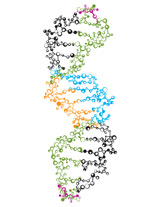
What do strawberries, cattle, corn and sheep all have in common? These plants and animals, as well as all living things, are made-up of cells. Within each cell is DNA. This DNA contains genetic material that makes strawberry taste sweet and corn stalks grow tall. DNA also affects the appearance of animals. Follow the procedure below to isolate DNA from your cheek cells.

Isolating Animal (Human) DNA
Materials
- Gatorade – any flavor
- Clear soap (dish soap, shampoo, hand soap, etc.)
- Rubbing alcohol – chilled or on ice
- Water
- Small cups (preferably clear)
Procedure
- Mix 1 part (example: 1 tsp.) soap with 3 parts (Example: 3 tsps.) water to create a soap solution.
- Swish approximately 2 teaspoons (10 mL) of Gatorade in your mouth for 30 seconds. This action collects cheek cells.
- Spit the Gatorade into a small cup.
- Add 1 teaspoon (5 mL) of the soap solution prepared in Step1, to the Gatorade. Mix gently for 2-3 minutes, trying not to create too many bubbles.
- Tilt the cup and pour 2-3 teaspoons (10-15 mL) of chilled rubbing alcohol down the side of the cup so a layer forms on top of the soap/Gatorade mixture.
- Allow the cup to sit for 1-2 minutes. A small clump should form where the two layers meet – this is your DNA!
Discussion Questions
- Why do you think Gatorade is used to collect cheek cells? (Gatorade has a high salt content which allows cheek cells to “stick” to it)
- Why do you think soap is mixed with the Gatorade containing your cells? (The soap causes the cell and nuclear membrane to break so the DNA is released from the nucleus of the cell)
- Why do you think the rubbing alcohol is used? (The cold alcohol causes an insoluble layer on top of the Gatorade/soap solution. The DNA clumps at this layer.)
Additonal Activities
- Observe different plants and animals and discuss what characteristics are influenced by DNA and genetics. Also discuss how environmental factors such as sunlight, water, temperature, nutrition, etc. can influence the appearance of plants, animals and humans.
For a more detailed description of this activity visit PBS Education Website:
http://www.pbs.org/wgbh/nova/education/activities/2809_genome.html
For further information about the Minnesota Agriculture in the Classroom program visit www.mda.state.mn.us/maitc or contact Al Withers, Program Director at alan.withers@state.mn.us or Sue Knott, Education Specialist at sue.knott@state.mn.us.











